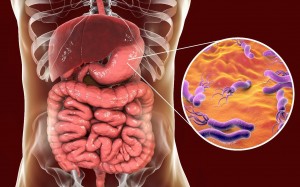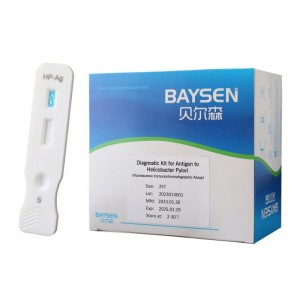What is the Long-Term Effects of Helicobacter Pylori on the Body?
Mr. Zhang, a 45-year-old man, had been experiencing recurrent episodes of upper abdominal pain, acid reflux, and halitosis for nearly a decade. He initially dismissed these symptoms as “ordinary gastritis” and self-medicated with over-the-counter stomach medications, which provided only temporary relief. Six months ago, however, he sought medical attention due to black stools. An endoscopic examination revealed a large ulcer in the gastric antrum with precancerous lesions, and a pathological report confirmed a positive result for Helicobacter pylori (Hp). The doctor noted with concern that the prolonged, untreated infection had caused irreversible damage to the gastric mucosa, significantly increasing his risk of gastric cancer.
ystemic Harm of Long-Term Hp Infection
✅ Digestive System: From Inflammation to Cancer
1. Chronic Gastritis and Ulcers
Helicobacter pylori penetrates the gastric mucosa with its spiral structure and secretes urease, which converts urea in the stomach into ammonia and carbon dioxide, neutralizing stomach acid and creating a persistent inflammatory environment on the mucosal surface. This chronic irritation gradually erodes the mucosal barrier, leading to chronic atrophic gastritis in 60% of infected individuals and gastric or duodenal ulcers in 30%.
2. Increased Risk of Gastric Cancer
The World Health Organization classifies Hp as a Group I carcinogen. Long-term infection causes DNA damage in gastric epithelial cells, initiating a carcinogenic pathway: normal gastric mucosa → superficial gastritis → atrophic gastritis → intestinal metaplasia → dysplasia → gastric cancer. This progression raises the risk of gastric cancer by 4–6 times, with approximately 90% of non-cardia gastric cancers linked to Hp infection.
3. Functional Dyspepsia
Hp infection alters the gastric environment, impairing digestive function and leading to symptoms such as acid reflux, heartburn, belching, and halitosis.
✅ Systemic Effects Beyond the Digestive Tract
1. Hematological Disorders
Hp competes for iron and inhibits gastric acid secretion (which is essential for iron absorption), resulting in refractory iron-deficiency anemia, particularly in pediatric patients. Additionally, idiopathic thrombocytopenic purpura, vitamin B12 deficiency, and mucosa-associated lymphoid tissue (MALT) lymphoma have been linked to Hp infection.
2. Association with Cardiovascular Diseases
Hp infection promotes systemic inflammation, contributing to the development and progression of coronary heart disease (CHD). Studies indicate that individuals with Hp infection face a 1.48 times higher risk of CHD compared to non-infected individuals.
3. Skin and Metabolic Abnormalities
Clinical research has identified connections between Hp infection and chronic urticaria, rosacea, and other dermatological conditions. The bacterium may also exacerbate metabolic syndrome by interfering with insulin signaling pathways.
4. Impaired Growth in Children
Infected children often experience stunted growth in height and weight due to impaired nutrient absorption, with only a 10% spontaneous clearance rate.
Screening Tools
Stool HP Antigen Test
Among various diagnostic methods, the Helicobacter pylori stool antigen test stands out for its unique advantages:
1. Non-Invasive and Convenient
Requires only a stool sample, eliminating the discomfort of endoscopy or concerns about radiation exposure (as with breath tests). This makes it particularly suitable for children, pregnant women, and elderly patients.
2.Accurate Detection of Active Infection
Directly identifies Hp antigens in stool, avoiding false positives from past infections (unlike serological tests).
3. Effective for Monitoring Treatment
Allows for follow-up testing 4–8 weeks after treatment to assess eradication success, providing earlier feedback than breath tests.
4. Efficient for Mass Screening
Ideal for large-scale community screenings, with no need for fasting or medication adjustments.
Eradicating Hp can significantly reduce the risk of gastric cancer. Current guidelines recommend the urea breath test (UBT) as the primary diagnostic tool, with the stool antigen test serving as a supplementary method or alternative for patients unable to undergo UBT. For high-risk individuals like Mr. Zhang, the following measures are advised:
- Family-wide screening and treatment (household transmission rates exceed 60%)
- Annual endoscopic follow-ups to monitor mucosal changes post-treatment
- Strict meal segregation to prevent reinfection
The long-term harm of Helicobacter pylori is akin to “boiling a frog slowly.” Timely screening and standardized treatment are critical to halting the progression to cancer.
Conclusion
We Baysen Medical is always focus on diagnostic technique to improve the quality of life . We have developed 5 technology platforms- Latex , colloidal gold , Fluorescence Immunochromatographic Assay , Molecular,Chemiluminescence Immunoassay. Our Hp-Ag,Hp-Ab test ,Hp-Ab-s test can quickly test for Helicobacter Pylori Virus infection
Post time: Apr-15-2025

